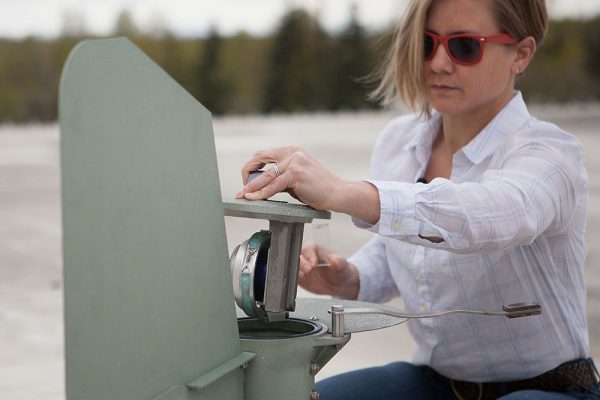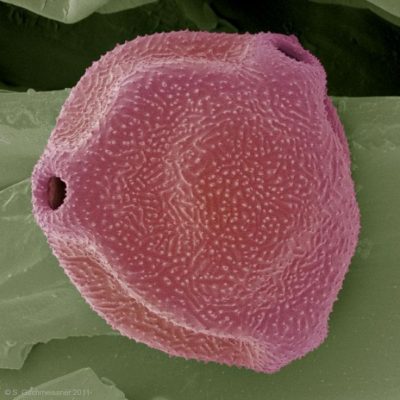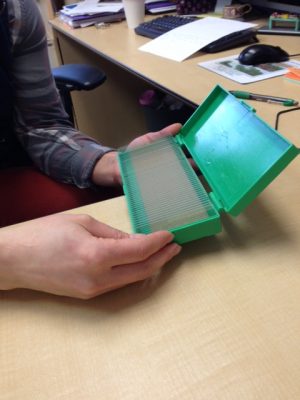UAA collaborates to keep Anchorage pollen counts online
by Kathleen McCoy |

UAA public health professor Liz Hodges Synder taking a pollen sample. The apparatus is a Burkard Volumetric Spore Trap. UAA, a local allergy clinic and the Municipality of Anchorage are collaborating to keep the pollen counts happening and posted publicly. (Photos by Phil Hall, UAA, unless otherwise noted.)
Ker-CHOO!
If that was you sneezing just then, this story is for you. UAA is a new partner with the Allergy, Asthma and Immunology Center of Alaska in keeping the only Anchorage pollen count website up and available so doctors and the pollen-averse can be readily aware of environmental sensitivities.
In spring, Sneezes-R-Us here in the far north, when our limited growing season means plants grab for their reproductive opportunities with gusto. After a sunny May day, it seems trees practically spray us with pollen; you literally can wipe a yellow film off your backyard picnic table. Alaska is often dubbed the birch pollen capital of the world, though that can be an exaggeration.
But one year, 2014, on May 9, it was fact. Anchorage's tree pollen count climbed to 2,862, (a count of 100 is considering high) something that prompted local allergy doctors to acknowledge that on that day, at least, Anchorage had one of the highest birch pollen readings on the globe.

Microscopic view of birch pollen. (from Pinterest)
The facts are that pollen rates vary year to year, and one bad year does not beget another bad year. In addition, Scandinavian countries can rival Alaska, and, Fairbanks can rival Southcentral, easily leaving Anchorage in the birch-pollen dust. Back in that same intense year-2014- Fairbanks recorded a May 5 pollen count of 3,675. With numbers like that, it's no surprise that a Fairbanks clinic maintains a pollen count site, as well.
While the pollen floating around out there is still mostly birch, the current Anchorage report shows tendrils of alder, spruce and cottonwood pollen. The grasses pollinate in late June, rivaled by weed pollen and even dry mold-also in June. If you associate mold with dampness, though, you'd be correct. Mold gets a straight run from June through mid-September. You can find a pollen and mold calendar on the city's website.
So there's a very good reason your throat is scratchy, your eyes are watering and itchy this time of year.
Partnerships
UAA is new to this pollen count effort. Historically, we can thank the Municipality of Anchorage Environmental Health Services office, and city employee Anne Schlapia, for maintaining pollen counts from 2010 to 2015. An EPA grant financed the purchase of monitoring equipment, and the city got assistance from a local environmental firm. Those historical pollen numbers are still available on their site.
Before that, local pollen historians say Dr. Jeffrey Demain maintained pollen counts while on active duty at Anchorage-area military bases. The pollen count effort that UAA has just joined still includes Demain, now in private practice. When city resources for maintaining the pollen counts declined a few years ago, Demain, with the Allergy, Asthma and Immunology Center of Alaska, stepped up. The clinic, with financial help from Providence Hospital, supported the pollen count and public posting for the last two years.
UAA's role
Now, UAA joins the community effort. Liz Hodges Snyder, a public health professor in the UAA College of Health, is donating her time to collect 24 hour-cycle pollen counts twice a week from the roof of a UAA Bragaw building.

Like a weather vane, the pollen sampler faces into the wind. A sample cycle is 24 hours.
Members of the allergy clinic staff stain the slides and do a manual microscopic count for pollens captured during the cycle. The clinic posts the current pollen count twice a week on its website.
Maintaining the counts gives local doctors and residents a source of environmental information that can be important for health. The data also represent a baseline by which to measure environmental changes.
A small group working to maintain the counts-including training by Schlapia from the municipality, Dr. Melinda Rathkopf, Bryan Farthing and Dr. Laura Moore from the allergy clinic, and Hodges Snyder from UAA, originally thought students might be able to collect and count the pollen. But the work is technical and training-specific; turnover in a class might jeopardize the reliability of the count, not to mention necessitating repeated training. So, for now, trained clinic personnel are completing the actual counts.
Benefit for UAA
But there is still a strong upside for UAA students. As Hodges Snyder points out, UAA now has access to the pollen count data. As a public health practice program, students don't graduate without a significant public health project joined by community partners.

Hodges Snyder holds her case of prepared slides to insert into the pollen counting trap, "just like the ones you used in high school biology," she said. (Photo by Kathleen McCoy/UAA)
"We have public health students, and a slew of undergraduates in the health sciences major, and they all need projects that are community-oriented," she said. The pollen data will be a source of research ideas and projects.
Hodges Snyder co-chairs the Alaska Food Policy Council. Her research interests include food security, as well as water quality and sanitation issues. She is working with Aaron Dotson, a civil and environmental engineering professor at UAA, on the Alaska Water and Sewer Challenge to improve water quality in rural Alaska.
Though pollen is not her specific study area, she's spent her career behind a microscope and knows the value of protocols. She also saw tremendous value for public health students. It was easy for her to envision the kind of research they could do, including monitoring early arrival of pollen, the changing distribution of vegetation, changing timetables for the onset of spring, impacts on pollinators, and changing pollen patterns at higher altitudes.
"We have a history and a track record of commitment to community-engaged public health work.," Hodges Snyder said. "This is consistent with that mission, and a great opportunity for our students."
Benefit to medical community and health consumers
Dr. Melinda Rathkopf, board certified in allergy/immunology and specialized in pediatrics, treats patients at the allergy clinic and also teaches with WWAMI at UAA. She said the current goal is to continue the twice-a-week pollen counts. "We're just getting our feet wet this year," she acknowledged.
But over time, she and the others are ambitious to expand the value of the count, including outdoor mold monitoring as well as the frequency of the count.
"Over the long term, we'd like to have counts three times a week and be officially certified," Rathkopf said. No one in the state is certified, which means Alaska pollen counts do not appear on the National Allergy Bureau's website. Getting certified can be tough, Rathkopf noted, because testing covers pollens across the United States, not just what is found in Alaska. "We might never see ragweed here," she said, "but you'd have to be able to identify it."
Once certified, Alaska's counts would be more readily available to the public, including on smartphone apps, a boon to summer visitors and residents alike.
Blame it on the book club
Rathkopf smiled when she remembered where the clinic and UAA collaboration got started. It was at her book club. One member, a UAA professor who suffers from allergies, proposed the idea that UAA students might help keep the pollen count going if it was in danger of stopping.
While that turned out not to be feasible this year, the idea lead to other conversations that made it possible for UAA to house the monitoring equipment and assume the sampling responsibilities.
The monitoring equipment, a Burkard Volumetric Spore Trap, came from the municipality. A vacuum pump draws in a constant supply of air through a small opening oriented by a wind vane. Pollen, fungus, minerals and other airborne material adhere to an adhesive film place on a microscope slide.
Schlapia donated her time to train Hodges Snyder on the sampling protocol. For her, seeing the count continue is a source of satisfaction.
"We get lots of calls and interest," Schlapia said. The municipal website now directs the pollen-curious to the allergy clinic's site for the current counts. The joint effort drew media attention during last week's high pollen counts.
Written by Kathleen McCoy for the UAA Office of Advancement
 "UAA collaborates to keep Anchorage pollen counts online" is licensed under a Creative Commons Attribution-NonCommercial 4.0 International License.
"UAA collaborates to keep Anchorage pollen counts online" is licensed under a Creative Commons Attribution-NonCommercial 4.0 International License.









